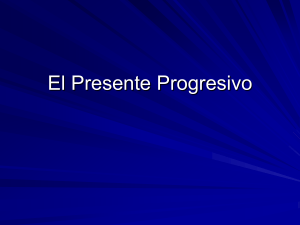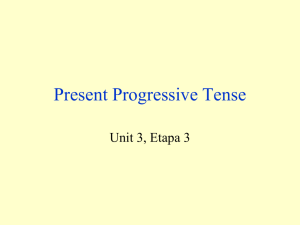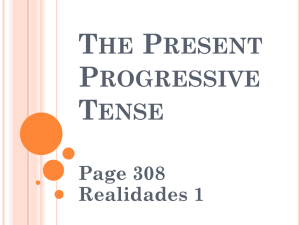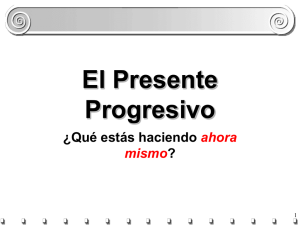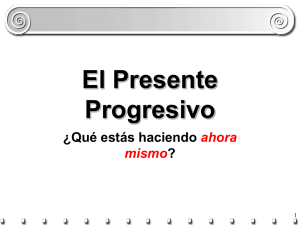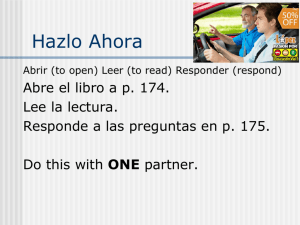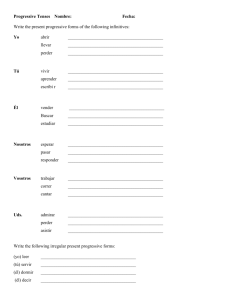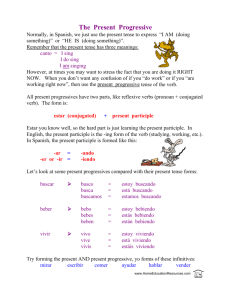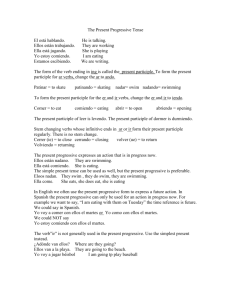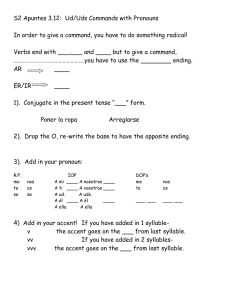El Presente Progresivo
advertisement
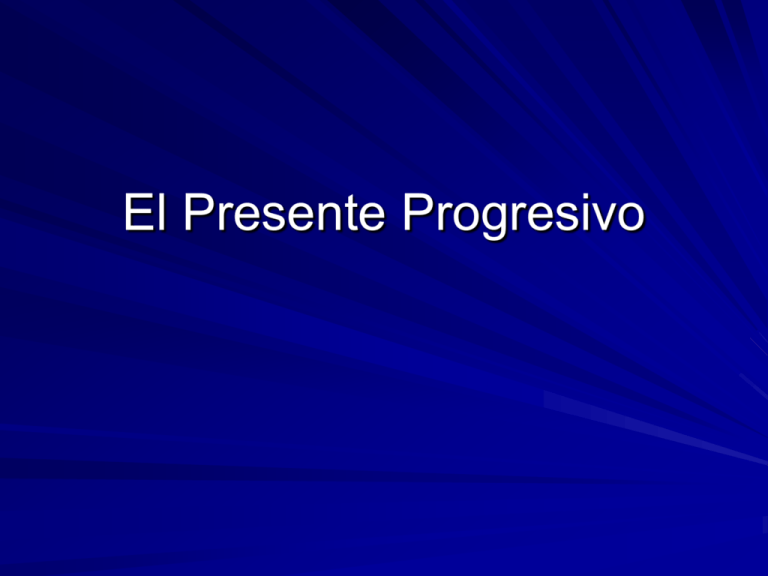
El Presente Progresivo Remember how you learned that to say “I am talking” you would write the same thing as “I talk” or “I do talk” in Spanish? “Yo hablo.” If something is happening RIGHT at the MOMENT, you can use the present progressive to show that the action is current. In ENGLISH, we call this the “gerund” or the -ING ending of a word. I am playing. You are reading. (these actions are happening now) In SPANISH: Here’s how… You start with Yo estoy the form of “estar” that fits the person you are Tú estás talking about. él, ella, usted está Nosotros estamos X Ellos, ellas, ustedes están Here’s how Then, after you have the correct form of estar, you make the –ING (gerund) of the verb (action word). (This is called the present participle… In case you want to know) Present Participle aka the –ING part of -AR verbs Take the infinitive, 1. 2. drop the –AR, 3. add –ANDO. Let’s try HABLAR: Yo estoy hablando Nosotros estamos hablando Tu estás hablando x Ella está hablando Ellos están hablando Try these! (En su paquete) Esperar = _________________________________ Ayudar = ________________________________ Trabajar = ______________________________ Bailar = ________________________________ Present Participle aka the –ING part of –ER and -IR verbs -Er and –IR verbs get the same endings. YAY. Drop the –ER, add -IENDO. Drop the –IR, add –IENDO. Let’s try COMER: Estoy comiendo Estamos comiendo Estás comiendo x Está comiendo Están comiendo ESCRIBIR: Estoy estamos estás está están All of you are waiting = _________________________________ The students are studying = _______________________________________ Are you working? = ______________________________ We are dancing = ________________________________ I am understanding = ____________________________ They are living = _______________________________ Irregulars When the stem of an –er or –ir verb ends in a vowel, change the “iendo” to a “yendo.” Leer Leyendo Oír Oyendo Creer Creyendo Are you reading now? ____________________________________ They are hearing the dog. ___________________________________ The students are not believing the news. ____________________________________ _______ Pedir, Servir, and Dormir stem-change in the present progressive: Pedir = pidiendo Servir =___sirviendo_____ Dormir = ______durmiendo______________ (Reír and Sonreír also change a bit: Riendo = laughing ______sonriendo________ = smiling) For all of the –ANDO and –IENDO words, you never have to pluralize or change them for the subject. You never make them feminine or masculine. YAY. Ella está trabajando, él está trabajando, ellos están trabajando. The progressive can also be used in the past to say what people were doing. To form the past progressive, take the imperfect tense of estar and add the same progressive endings. estaba estábamos Estabas X estaba estaban 1. Isabel was writing an article ___Isabel estaba escribiendo un artículo___ 2. Susana and I were reading the newspaper ____Susana y yo estábamos leyendo el periódico___ 3. Were you working late last night? ____¿Estabas trabajando tarde anoche?____ 4. My cousin was helping her greatgrandmother._________________________ ___________________________________ 5. Were the students starting the homework in class? __________________________________ 6. The earth (la tierra) was shaking(temblar) ___________________________________ __________________________________ 7. We did not know what was happening. ___________________________________ ____ 8. The reporters were taking pictures. ___________________________________ 9. The men were rescuing people and animals. ___________________________________ _____________________________ 10. The victims were asking for help. ___________________________________ _____________________________
